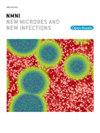Screening of yeasts in the oral microbiota of bats (Chiroptera) in Piauí, Brazil
IF 5.4
Q2 INFECTIOUS DISEASES
引用次数: 0
Abstract
Bats in Brazil play a crucial ecological role; additionally, these mammals are known hosts of potential zoonotic pathogens and pathogenic fungi. The increase in their interactions with humans and other animals, caused by anthropogenic pressure, can lead to the dispersal of pathogens. Despite this, the fungal microbiome of these animals in Brazil has been little investigated. This project aims to analyze the fungal microbiota of bats and identify potentially pathogenic yeasts in populations of the Cerrado and Caatinga. The study included 47 bats captured in Piauí, Brazil. Samples were collected from the oral mucosa and the isolated yeasts were identified by a polyphasic taxonomy approach, using techniques such as partial sequencing of genes from the ITS region and MALDI-TOF MS. It was possible to isolate 17 yeast samples, including the pathogenic yeasts Candida albicans, Candida tropicalis, Candida parapsilosis and Candida carphophila (Meyerozyma carphophila). The importance of continuous surveillance of the fungal microbiota of bats is highlighted, especially in ecologically sensitive areas such as the Cerrado and Caatinga. Detailed characterization of the oral microbiota of these animals contributes to the understanding of ecological interactions with fungi and provides essential data for strategies to prevent zoonoses and protect human and animal health.
巴西Piauí地区蝙蝠(翼翅目)口腔微生物群中酵母的筛选
蝙蝠在巴西扮演着至关重要的生态角色;此外,这些哺乳动物是已知的潜在人畜共患病病原体和致病真菌的宿主。由于人为压力,它们与人类和其他动物的相互作用增加,可导致病原体的扩散。尽管如此,巴西这些动物的真菌微生物群却很少被调查。该项目旨在分析蝙蝠的真菌微生物群,并在塞拉多和卡廷加种群中鉴定潜在的致病酵母。这项研究包括在巴西Piauí捕获的47只蝙蝠。利用ITS区部分基因测序和MALDI-TOF ms等技术,采用多相分类方法对分离的酵母进行鉴定,共分离出病原酵母菌白色念珠菌、热带念珠菌、拟合念珠菌和嗜车念珠菌(嗜车念珠菌)17株。强调了持续监测蝙蝠真菌微生物群的重要性,特别是在塞拉多和卡廷加等生态敏感地区。这些动物口腔微生物群的详细特征有助于了解与真菌的生态相互作用,并为预防人畜共患病和保护人类和动物健康的策略提供必要的数据。
本文章由计算机程序翻译,如有差异,请以英文原文为准。
求助全文
约1分钟内获得全文
求助全文
来源期刊

New Microbes and New Infections
Medicine-Infectious Diseases
CiteScore
10.00
自引率
2.50%
发文量
91
审稿时长
114 days
 求助内容:
求助内容: 应助结果提醒方式:
应助结果提醒方式:


